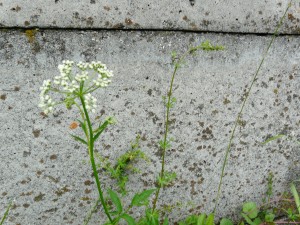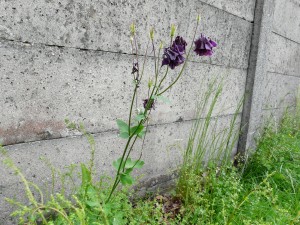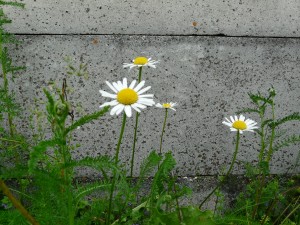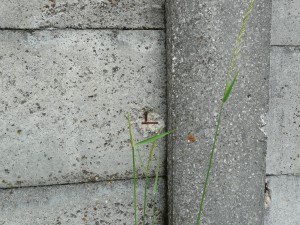June 6, 2010
I arrived in Munich in a rainy winter’s June morning, and twenty-four hours later was on the train out of Marienplatz and bound for Dachau. In a place made for destroying people, I was startled to see it filled and humming with plump, colorful, warm and fed and well-dressed and very much alive and arguably free people – site-seers, tourists, pilgrims, mourners, innocents, voyeurs. A spectrum of human intent, and a spectrum of human response.
There was the toddler who ran away from his mother and began playing in the loose stones that mark the ruins of Block 18. He was dandling his fingertips around the concrete perimeter – a perfect baby stability height. Gurgling and happy, he had freed his harness from its leash and his mother held it – a slack line. She chased after him, scolding him, until he began to cry and was replaced in his stroller and wheeled towards the crematorium. Throughout the camp, signs were posted at regular intervals suggesting that being at the site was inappropriate for children under thirteen.
This toddler, unable to read and tied into his stroller, proceeded through the iron gates and towards the gas chambers.
Outside the newer crematorium – at the entrance to the room where, towards the end of the war, the Nazis stored the murdered inmates after the coal ran out – a quartet of heterosexual Italian teenagers were learning the technical science of public lovemaking.
One boy sliding his hands adeptly up his sweetheart’s blouse, with squeals and fumbling and a sudden plummet of umbrella once both his hands became occupied. Suddenly drenched, they laughed, and caught the attention of the other boy, who emerged from behind his umbrella smeared with coral lipstick.
A woman hunched in silence at the ash grave laid a small stone in the grasses that covered the high rounded rise in the earth behind the ovens. She stared at the stone as though aware of its inutility.
In a damp wool sweater and no raincoat, no umbrella, water ran down her face. Behind her, the toilets – housed in the crematorium – contained a queue of multinational teenagers gossiping in all languages: how was the wurst in the Dachau cafeteria.
Did he really say that? Are you going to Minneapolis for the Fourth of July, or will you stay in Champagne-Urbana?
Yes, he’s your ex-boyfriend, but that doesn’t mean you still don’t love him, and hate her.
The blood drainage ditch was clearly marked at the execution range – a short walk down a long path into a grove of trees that have grown up alongside the concrete wall and barbed wire. Blackbirds crouching under the ivy leaves now grown on the wall, and two Japanese women sharing a large red umbrella stumbling in the moss.
A fairy ring of fat white June mushrooms caught their eye, with joy they pointed and smiled, until the engraved granite sign attesting to the blood ditch caused their feet to catch slightly and scuffle the gravel walkway.
They stopped, aghast, each with one shoulder dry as they leaned together into the handle of the umbrella. Their outer shoulders soaked with rain. And in the blood ditch, a rich pelt of ferns, and violets.
The Dachau museum now offers a cinema – it’s located in what had been a processing station for incoming prisoners, and has the feel of an auditorium at a small liberal arts college in the American midwest. People sit on long wooden benches and don’t interact. Each language is screened at the half-hour. People from the same town meet at Dachau, and discuss how ruined their shoes are in the mud, and others wear dark sunglasses inside, or shelter their faces with their hands, or stare quietly at the floor. Many people brought children to the film and at first, the children were excited: Finding Nemo would come next, perhaps, or perhaps a cartoon with a droll green troll.
Three small children aged three, six, and eight were bracketed by their parents. Two girls had sweetly sculpted afros, and their sister’s hair was done in two ponytail puffballs on their heads, leaving a charming minnie mouse silhouette against the images of the dead and tortured.
As the film progressed, the parents began shivering, and the father shed tears that shone silver in the illumination of the black and white footage. He held hands with the mother, their long arms stretching tightly towards one another across the back of the pew.Their small girls shrunk into the hard back angle of the pew and curled into small mounds of child, facing away from the screen, hands nested into their hair and covering their ears, and soon fell asleep holding onto one another in a grieving, nuzzled heap.
And for three hours in the intermittent thunder, rain, and small glimpses of color through the clouds, I followed the camp wall back to where Block 31 once stood. I sat down in the swampy grass, in the middle of what is now an open grassy ground pocked with black trails of mole tunnels, but was once where the Dachau brothel stood.
It’s where six women lived, some lesbians, who were shipped down from Ravensbrück by the SS to serve as forced prostitutes.
Block 31 isn’t marked on the maps handed out to visitors at the information centre. But it’s visible from aerial photographs made by the Americans. A small structure alongside the barbed wire, and watched over by two guarded gun towers.
It’s hard to know where to mourn, when you’ve come to visit that place. There are no heaps of ashes, no piles of stone, nothing etched in granite or marble, no corresponding number posted on a map or an audio guide.
I chose to visit with the flowers – some purple, some yellow, some white. And grasses, almost in seed. And a spiky plant with thorns that grows low to the ground, and dark. And a tangled mess of tendrils – fuzzy and pale – whose vines turned in on themselves in corkscrews and curls. Like a head of hair, pressed thick and hard against the wall.







